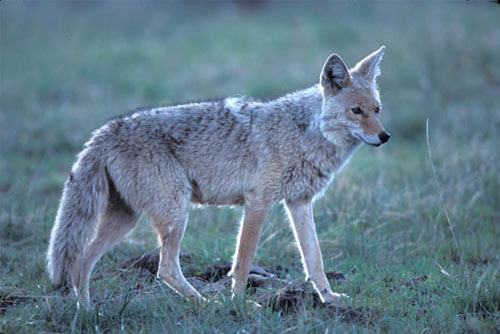Eastern Coyotes
Eastern coyotes are visually comparable to German Shepherd dogs, but are generally about half the weight. They are recognizable by their bushy tails and large, pointed ears. Their coats can vary in color, but are generally blonde or reddish blonde, tan, or mixed with black.
On average, adult coyotes are between 4 and 5 feet long, and weigh between 35 and 45 pounds. As with many other species of mammals, male coyotes are typically larger than females.
Coyotes eat a variety of different plants and animals, including deer, rabbits, mice, raccoons, groundhogs, birds, insects, and berries, depending on what is most easily available at any given time of year.

The History Of Coyotes In The Adirondacks
As wolves were driven out of the Adirondacks, it opened the door for coyotes to fill that vacated niche.
Some researchers speculate that the presence of coyotes in the Adirondacks pre-dates Europeans settling in North America, others believe that the species initially inhabited the mid-west, and naturally passed north of the Great Lakes and into northern New York as deforestation subsided.
Coyotes were originally documented in New York State in the 1930s, and the population has been significant throughout the state since the 1970s.
The Current Coyote Population
Unlike wolves, coyotes don't establish true "packs" with other adults, and instead travel in "family units". Coyotes are extremely territorial, and therefore are unlikely to cross into the territory of a different family.
The DEC reports that a SUNY College of Environmental Science and Forestry study "estimated that there are approximately 14,500 breeding pairs of coyotes in New York during the summer," and identified coyote density estimates as being around 2.5 pairs/10 square miles in the Adirondack Mountains and St. Lawrence and Mohawk River Valleys. This density decreases to 1 breeding pair/10 square miles in the Lake Plains.
Although coyotes have historically preferred wooded habitats, they do inhabit suburban and urban areas at times. While the species is not known for aggressing humans, they do pose a serious risk to domestic pets.
Avoiding Conflict With Coyotes
Coyotes are typically afraid of humans, and therefore avoid them, but if they start to make a connection between people and food, it can cause conflicts.
The Department of Environmental Conservation recommends the following steps to minimize the possibility of conflicts between people or pets and coyotes, and to maintain coyotes' natural fear of humans:
- Do not feed coyotes, and remove or secure possible food sources - like garbage cans, pet food dishes, compost piles, and birdfeeder spillage - so coyotes can't access them
- Don't allow coyotes to approach you or your pets, and teach children to keep their distance from coyotes
- If you see a coyote, make yourself appear large by standing tall and holding your arms out. You can also be aggressive in your behavior by making loud noises, waving your arms, or throwing sticks and stones if the coyote lingers for too long
- Prevent pets from running free, especially small dogs and cats
- Fence your yard to keep coyotes out; an ideal fence is at least 4 feet tall and extends at least 6 inches below ground level
- Remove areas of brush and tall grass from your property, as coyotes are attracted to these types of environments
- Contact your local police department or your NYSDEC regional office for assistance if there is a particularly bold coyote in your area
- Ask your neighbors to follow the same steps
Coyote Fun Facts
- To communicate, coyotes howl, yelp, cry, bark, growl, wail, and squeal
- Coyotes sometimes walk on their toes to avoid making noise
- Coyotes sleep and give birth in holes in the ground
- Hunting is typically done in groups of 2-3
- Coyotes can sense hunters from a mile away
- At top speed, coyotes travel 40 miles per hour
- Contrary to popular belief, coyotes are not strictly nocturnal
- Coyotes mate for life
- Litters generally contain 4-6 pups
- Coyotes are full grown at 9 months
Want more wildlife? Check out our Dangerous Animals Guide »
Sources of Information:
http://www.dec.ny.gov/animals/9359.html
http://www.dec.ny.gov/pubs/97143.html
http://www.animals-zone.com/10-facts-you-did-not-know-about-coyotes